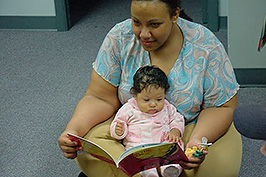Today’s parents of young children are much more comfortable with communication technologies than were the generation of parents who preceded them, as a significant U.S. report released yesterday confirmed. These parents are using technologies like the TV, smartphones, computers, and tablets to manage family life and to keep children occupied. And as children grow older, parents and children are much less likely to spend time together in mediated activities. Joint media engagement drops off markedly for children who are six or older, according to this study. What will this mean for U.S. families? It might mean that parents will have to prepare children for a world that requires intentional effort as we seek to maintain the bonds that matter most to us, as this blog post will report.
Findings from the just-released report, titled, Parenting in the Age of Digital Technology, were announced as part of a conference with the same title held at the offices of the Pew Charitable Trusts and that I was able to attend. The conference brought together speakers who have conducted extensive research on the media in family life both for general audiences and for specific educational and media industry applications. This post will discuss both the report and the conference, focusing specifically on findings and implications for parents, caregivers, and those who provide support and programming for families of young children.
The Parenting report was based on a nationally representative survey of more than 2,3000 parents of children aged 0 – 8. Ellen Wartella, director of Northwestern’s Center on Media and Human Development and lead author of the report, said that the study “reveals a generational shift in parental attitudes about technology’s role in young children’s lives.”
Digital media don’t even make the list of things that parents are “very concerned” about, said Vicki Rideout, coauthor of the report. Health and safety, fitness and nutrition, and social and emotional skills top that list.
The report confirms the rapid adoption of smartphones and tablet devices in the homes of those who have children aged 0-8, noting that 71% of these households have a smartphone, 42% have a tablet device, and 35% have both. The study confirms that most parents (70%) don’t think that these technologies have made parenting any easier. Many parents still would prefer to rely on other alternatives, such as books, toys, or other activities when they’re looking for educational opportunities, when they want to keep children occupied, and when they want to reward good (or punish bad) behavior.
The study also confirms the enduring economic gap related to ownership of tablet devices: 65% of households with incomes above $100,000 own a tablet, whereas only 19% of households with incomes below $25,000 do. The study finds that there are different types of family environments, and that these are also related to income:
• 39% of families are media-centric, consuming an average of 11 hours of screen time each day. These families are very or somewhat likely to use tv to keep children occupied (81% say this). About half of these families leave the tv on all or most of the time and about half (44%) have a tv in the child’s bedroom. Children in these families spend an average of 4.5 hours a day with screen media (remember, these are homes with children who are 0 – 8 years old). Lower income families tend to fall into this category.
• 45% of families are media-moderate. They spend just under 5 hours a day with screen media, and would prefer to spend their leisure time outside rather than in. Children in these families spend just under 3 hours a day with screen media.
• 16% of families are media-light. These parents spend less time with screen media, are less likely to use tv when getting children ready for bed, and children in these families spend about 1 ½ hours with screen media. This category is associated with parents who have higher levels of both income and education, although there are families from every income level in each of these categories.
These three categories echo Sonia Livingstone’s analysis of the “media-rich,” “traditional,” and “media-poor” homes she observed in her studies of media in the U.K. homes of families with children. Livingstone also found a relationship between media use and income.
In the U.S. context, there’s also a relationship between heavy media use and the increasing stress of managing a household where both parents work and where a diminished economic safety net means that work often intrudes upon family life, as Elinor Ochs, Distinguished Professor of Anthropology at UCLA, reported. Ochs and her research team have just published the results of a large-scale ethnography of U.S. middle-class families that documents the hectic and often stressful lives of parents in two books: Fast Forward Family and Life at Home in the 21st Century. At the conference where the Parenting report was released, Ochs showed poignant photos of backyards that sat empty as families retreated to separate indoor (and often mediated) activities in the scarce hours at home. In their study, she and her colleagues found that fully half of parents’ leisure time was spent with the television; most families had 3 tvs; 80% had tv in parents’ bedroom; and 47% had a tv in the child’s bedroom.
For those interested in media use, one of the key takeaways from the CELF study by Ochs and her colleagues is that children’s technology use is entwined in unclear family role expectations, routines, and rules. Tasks are negotiated rather than delegated, and the child’s individual entitlement trumps obligation in many households. Parents seemed uncomfortable interrupting media use or setting clear expectations about when such use could begin or needed to end. Ochs showed footage of fathers coming home from long workdays to children too engrossed in video games to acknowledge the father’s return, and mothers struggling to extract children from television-viewing in order to get them to school on time. Ochs, who is Director of the UCLA Center on the Everyday Lives of Families (CELF), argued that we have to see parental regulation of media use in the context of how families today are living their lives.
Such struggles over media use raised questions about the self-reports of parents who responded in the Parenting study that children’s media use was not a source of family conflict. Maybe the struggles that Ochs and her team observed are more unusual among families with children younger than age 8. Or perhaps families of young children do not envision such occurrences as “family conflict” but as personal struggles over how to be good parents for children immersed in a mediated environment.
This led to one of the key discussion points of the conference: The responsibilities of parents, and of experts who would advise parents, have shifted.
Instead of looking for guidelines about how much is too much screen time, we need to encourage parents to think about teaching time management and we need to provide young people with opportunities to learn how to remove themselves from or end screen time. Michael Rich, Associate Professor at Harvard Medical School and advice author at askthemediatrician.org, suggested that families consider instituting a “digital Sabbath” in which they experience life together and apart from technologies. He also noted that this is often harder for parents than for their children. Barbara Fiese, Professor at the U of Illinois at Urbana-Champaign, noted the importance of encouraging healthy habits in the whole “family ecology” of which media ecology is one part.
 Another key discussion point of the conference: We need to remember that we don’t all experience media in the same way.
Another key discussion point of the conference: We need to remember that we don’t all experience media in the same way.
This was one of the points I wanted to make, as I observed that not all families even want to adopt a “media-light” position. I noted that the “helicopter parent” or “concerted cultivation” approach to parenting tends to keep families too busy to watch television and is framed in relation to viewing all leisure as a waste of time. Media are only seen as positive in these families when they fit within what I term an ethic of expressive empowerment. However, not all parents can engage in the kind of concerted cultivation activities that tend to make media use lighter. They may face economic, health, language, or job- or transportation-related challenges. Or their neighborhood’s not safe and so staying inside with media is a positive alternative.  What’s more, “helicopter parenting” and concerted cultivation are rooted in the idea that young people can achieve and improve their lives through participation in existing societal structures, whether that’s school, sports, or the arts. But while families facing greater economic challenges hope that these things will help, they don’t trust that they will. They look to their families, neighborhoods, friends and communities to help their children develop the resilience they will need to face the challenges of racism, prejudice, and structural inequalities. These families approach media with an ethic of respectful connectedness: to the extent that media can help parents and family members to stay connected and to remain respectful of who they are and where they’ve come from, media can be seen as useful and helpful in relation to family goals.
What’s more, “helicopter parenting” and concerted cultivation are rooted in the idea that young people can achieve and improve their lives through participation in existing societal structures, whether that’s school, sports, or the arts. But while families facing greater economic challenges hope that these things will help, they don’t trust that they will. They look to their families, neighborhoods, friends and communities to help their children develop the resilience they will need to face the challenges of racism, prejudice, and structural inequalities. These families approach media with an ethic of respectful connectedness: to the extent that media can help parents and family members to stay connected and to remain respectful of who they are and where they’ve come from, media can be seen as useful and helpful in relation to family goals.
Vikki Katz, Assistant Professor at Rutgers University who has studied Latino immigrant parents and their children in LA, also reinforced this idea. She reminded us that many people don’t take work home with them via their smart phones, for instance – but on the flip side, in order to make ends meet, many also have to work longer hours and not at times of their own choosing. She also reminded us that it’s important not to pathologize families who have economic struggles. They have the same goals as the rest of us when it comes to wanting the best for their children and in their hopes for the “American dream,” and those of us working in areas of policy, research, and industry need to seek to provide support for them on their own terms.
Other speakers at the conference included:
Richard Culatta, Acting Director, Office of Educational Technology, US Department of Education; Kelly Pena, Senior Vice President for Research at Disney Channels Worldwide; Leticia Barr, Tech Savvy Parent blogger with Parents magazine; Linda Villarose, former health reporter and editor at The New York Times; Michael Levine, Executive Director of the Joan Ganz Cooney Center (who gave a quick review of important research to come), and George Askew, MC, Chief Medical Officer, Administration for Children and Families, U.S. Department of Health and Human Services.
Thanks especially to Ellen Wartella, Vicky Rideout, the Pew Charitable Trusts, Emily Kirkpatrick who is VP of the National Center for Family Literacy, and Sabrina Connell and the many other graduate students from Northwestern and from Georgetown University who made this conference possible!







